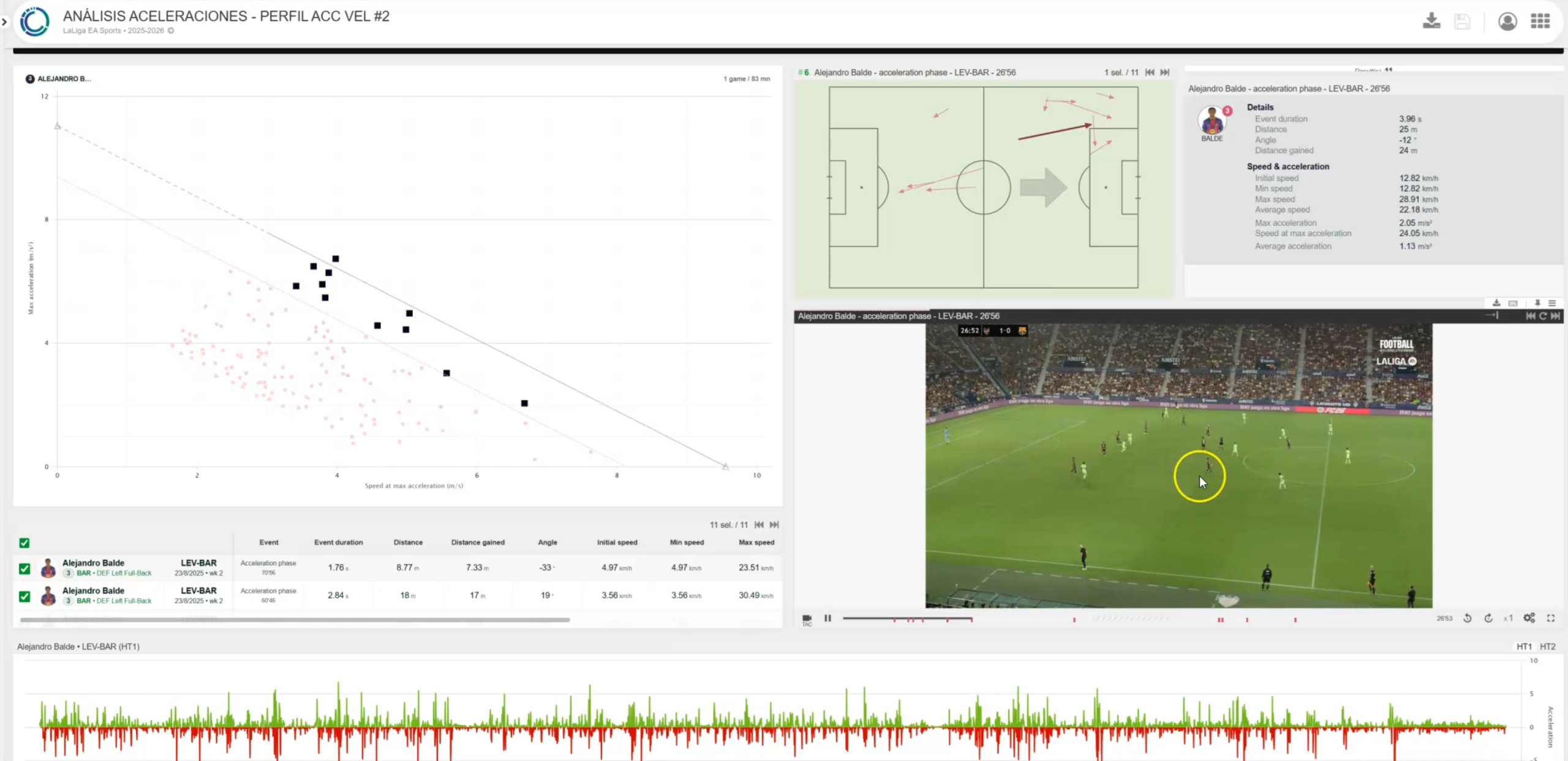
27 Ago Accelerations: The Hidden Metric That Shapes Football Performance
“It’s not how fast you run, but how often you can explode, stop, and repeat.”
A coach’s dilemma on the pitch
Imagine this: your team dominates possession, but when the decisive moments arrive, the opposition outruns you—not in total distance, but in how quickly and often they accelerate to win duels, press, and counter.
Traditional metrics like distance covered or top speed don’t explain these moments. What makes the difference is something less visible but far more decisive: accelerations and decelerations.
From research to practice: 6 studies, one framework
At the Football Intelligence & Performance Department of LALIGA, we’ve published six peer-reviewed studies on accelerations in elite football. Each study adds a piece to the puzzle: technology validation, new methodologies, positional demands, links to team success, and even the effect of age.
Together, they form a framework that any coach or performance staff can use to better monitor, interpret, and train the game’s most explosive actions.
How we studied accelerations in elite football
- Technology validation: We compared optical tracking (TRACAB/Mediacoach) with GPS and IMU systems. Results showed very high agreement, but also systematic underestimation at extreme intensities. This means data is valid, but practitioners must be cautious when mixing systems.
- Integration of systems: By combining video-tracking and wearables, we created robust datasets that allow training and match data to be compared consistently.
- Acceleration–Initial Speed (A–S₀) profiles: Fixed thresholds (e.g., >3 m/s²) are misleading. Efforts starting from low speed are overestimated, while those at higher initial speed are underestimated. The A–S₀ method corrects this and reveals positional differences more accurately.
- Team success link: Teams with higher acceleration/deceleration capacity tend to achieve better results, particularly in roles like central midfielders, full-backs, and wingers.
- Positional demands: Each role has its own acceleration signature. Training should reflect these patterns—central defenders brake more, wingers burst more often.
- Age effect: Older players (31+) maintain peak acceleration ability but show fewer total efforts across matches, highlighting the need for tailored load management.
What this means for coaches and performance staff
1. Trust but calibrate your technology
GPS and optical systems are reliable, but not identical. Avoid mixing raw values across platforms. If you must, apply correction or regression adjustments.
2. Go beyond thresholds
Stop thinking of accelerations as “above or below 3 m/s².” Use acceleration–speed profiles to understand context. A 2.5 m/s² effort at high speed may be more demanding than a 4 m/s² burst from standing.
3. Train the right profiles by position
- Wingers → high frequency of intense accelerations.
- Central defenders → repeated strong decelerations.
- Midfielders → balance of both, high density.
Tailor drills so players reproduce their competitive acceleration signatures.
4. Manage veterans differently
Players over 30 can still hit maximum bursts—but they accumulate fewer. Focus on quality over quantity, and design recovery to preserve repeatability.
5. Decelerations are load multipliers
Remember that stopping is often more demanding than starting. High deceleration exposure can raise muscle damage and injury risk. Plan progressive loading and monitor density, not just totals.
Why accelerations matter for winning
Our studies show that acceleration capacity is linked to team success. Not simply because players move faster, but because they arrive first in decisive actions: pressing, transitions, counter-attacks, and recovery runs.
Accelerations are the currency of intensity. Training them, monitoring them, and contextualizing them can be the difference between dominance and defeat.
Beyond academia: application through technology
Thanks to our partnership with Footovision, all this scientific knowledge has been implemented in Coach Vision (formerly Mediacoach Vision). This platform transforms research into direct application, allowing physical coaches across the 42 clubs of LALIGA to monitor and analyze accelerations in real time.
This is where science meets the pitch.
Limitations and next steps
As always, context matters:
- Results come from professional players in LALIGA; lower levels may present different patterns.
- Technology differences mean values are not interchangeable without adjustment.
- Accelerations should be combined with tactical context (phase of play, ball possession) for deeper insight.
Future research will explore how accelerations interact with tactical structures and decision-making, moving closer to a fully integrated performance model.
Scientific References
- Locomotor characteristics of intense accelerations according to the playing position in top Spanish football teams during competition. https://doi.org/10.5114/biolsport.2025.151652
- Acceleration-speed profiles in LaLiga: the influence of initial running speed and differences between positional roles in elite football players. https://doi.org/10.5114/biolsport.2025.150035
- Impact of Acceleration and Acceleration-Initial Speed Profiles on Team Success in LaLiga. https://doi.org/10.3390/app15084344
- Validity of Coupling TRACAB’s Gen5 and Mediacoach Systems to Calculate Accelerations and Decelerations in Professional Football. https://doi.org/10.3390/s25061804
- Integrating video tracking and GPS to quantify accelerations and decelerations in elite soccer. https://doi.org/10.1038/s41598-021-97903-2
- Effects of Age on Match-related Acceleration and Deceleration Efforts in Elite Soccer Players. https://doi.org/10.1055/a-1337-2961
Conclusion
Accelerations and decelerations are no longer hidden metrics. They are validated, contextualized, and proven to influence performance and success in elite football.
For coaches and performance staff, the challenge is clear:
- Measure wisely.
- Interpret with context.
- Train what the game demands.
Because in modern football, it’s not just about running fast—it’s about accelerating at the right moment, again and again.


